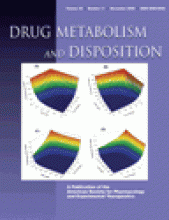Abstract
Enzyme kinetics of GTI-2040 (5′-GGC TAA ATC GCT CCA CCA AG-3′), a phosphorothioate ribonucleotide reductase antisense, were investigated for the first time in 3′ exonuclease solution and human liver microsomes (HLMs), using the ion-pair high-performance liquid chromatogram method for quantification of the parent drug and two major 3′N-1 and 3′N-2 metabolites. Enzyme kinetics of GTI-2040 in 3′-exonuclease solution were found to be well characterized by the Michaelis-Menten model, using the sum of formation rates of 3′N-1 and 3′N-2 (∼total metabolism) because of sequential metabolism. In HLMs, a biphasic binding was observed for GTI-2040 with high- and low-affinity constants (Kds) of 0.03 and 3.8 μM, respectively. Enzyme kinetics of GTI-2040 in HLMs were found to deviate from Michaelis-Menten kinetics when the total GTI-2040 substrate was used. However, after correction for the unbound fractions, the formation rate of total metabolites could be described by Michaelis-Menten kinetics. Using the free substrate fraction, the Km and Vmax of GTI-2040 were determined to be 6.33 ± 3.2 μM and 16.5 ± 8.4 nmol/mg/h, respectively. Using these values, in vitro hepatic intrinsic clearance (CLint) in HLM was estimated to be 2.61 ± 0.56 ml/h. The CLint was then used to predict GTI-2040's in vivo intrinsic clearance in humans by a microsomal protein scaling factor, which gave a mean value of 182.7 l/h, representing 24.1% of the observed in vivo mean scaled hepatic intrinsic clearance of 758.7 l/h in patients with acute myeloid leukemia. We concluded that the saturable nonspecific binding of GTI-2040 in HLMs complicated the interpretation of its enzyme kinetics, and scaled intrinsic clearance from HLMs only partially predicted the in vivo intrinsic clearance.
Footnotes
-
This study was supported by the National Institutes of Health (Grant NCI R21 CA 105879; to G.M.).
-
doi:10.1124/dmd.108.021295.
-
ABBREVIATIONS: ODN, antisense oligonucleotide; PS-ODN, phosphorothioate antisense oligonucleotide; CLint, in vitro hepatic intrinsic clearance; GTI-2040, 5′-GGC TAA ATC GCT CCA CCA AG-3′; AML, acute myeloid leukemia; HPLC, high-performance liquid chromatogram; HLM, human liver microsome; IS, internal standard; PS-dC 28, 28-mer polycytidine phosphorothioate oligonucleotide; TEAB, triethylammonium bicarbonate; TEAB, triethylammonium bicarbonate; HFIP, 1,1,1,3,3,3-hexafluoro-2-propanol; ELISA, enzyme-linked immunosorbent assay; fu,p, free fraction of GTI-2040; CLR, renal clearance; CrCL, creatinine clearance; CLint,h, estimated intrinsic clearance from patients; CLint,h1, scaled hepatic intrinsic clearance; fu(mic), free fraction associated with microsomes.
-
↵1 Current affiliation: Sanofi-Aventis U.S. Inc., Malvern, Pennsylvania.
- Received February 29, 2008.
- Accepted July 23, 2008.
- The American Society for Pharmacology and Experimental Therapeutics
DMD articles become freely available 12 months after publication, and remain freely available for 5 years.Non-open access articles that fall outside this five year window are available only to institutional subscribers and current ASPET members, or through the article purchase feature at the bottom of the page.
|






